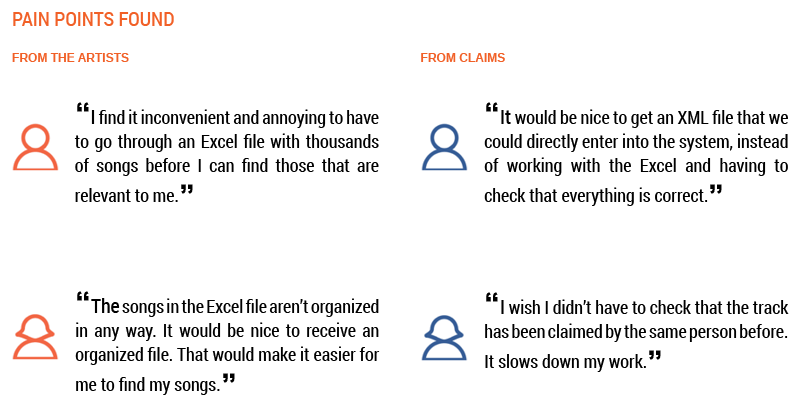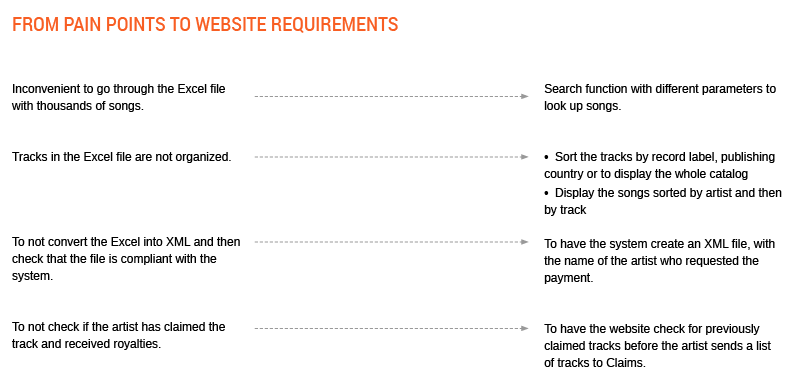Automation of a Process for Royalty Collection
UX goal: to create an online platform that streamlines the manual process of paying royalties via "20%-puljen" for both artists and the Claims Department (Claims), in order to reduce manual efforts for both of them, minimize errors and facilitate payments.
About the project
• Client: Gramex.
• Project date: Apr - Jul 2016.
• My role: I worked on this project as a UX Designer and the Programmer with the following main areas of responsibility:
• User interviews
• Desk research
• User Journey mapping ("as is" and "to be")
• Wireframing
Design Process

Challenge
Due to internet policy it was not possible to contact the external users (the artists). To have their point of view represented, I relied on customer logs and the knowledge from Claims, who were in contact with the artists for this part of the process.
The Trigger
20%-puljen is one way in which artists can collect royalties for tracks they have collaborated in. Claims has handled this process manually and requested to have a website that can automate it.
UX Research
To understand the task at hand, I held an interview with Claims, where I learned what the whole process was about. We went through feedback received from the artists about their experience. Then, by means of a workshop we mapped out the user journey, both from the artists’ and from Claims’ perspective.
The user journey was a way to make sense of the information, to identify and place pain points through the journey, with the intention to create empathy with the persons involved in this service.

Going through the customer logs, I found useful feedback that shed light on how the artists felt about the process. Then, I added feedback from Claims, which was obtained during the contextual interview.

Translating UX Research Learnings into Requirements
From these pain points I derived an initial list of requirements for the website.

Wireframing
Once I had the requirements, then I produced low fidelity wireframes for each of the pages that would form the website. The website resembled an online shop



Programming the Solution
The solution is a website with the structure and behavior of an online shop. The landing page gives artists 3 possibilities to access the track catalog. After choosing the point of entry, they will fill in a form with their information. Then the tracks will be displayed according to the selected point of entry, for ex. The Sony tracks will be shown if the artist chose Sony as their record label.
Here the artist will choose or search for the tracks they want to claim, add them to a “cart”, upload the pertinent documentation and send the request to Claims. Claims will receive a link pointing to the files, including an XML file that they will enter into another internal system to generate the payment.
The website features:
• Pagination: to display the 4000 tracks, where the user can choose how many tracks to show
• Form verification: that all required fields are filled in, basic e-mail validation, etc.
• Checks for song duplicates, approved file formats, file size, songs added, that the artist has not claimed the same song within the claiming period, etc.
• Success, information and error messages.








Usability Testing and Implementation
After programming the website, I conducted a usability test in Think-aloud mode with internal users, who requested minor changes in the language used. I adjusted the website and implemented it.
Presentation
The solution pleased Claims. The website facilitates the process of sending requests for the artists, and makes it efficient for Claims to handle incoming requests, expediting the processing of payments.
As a next step, I recommended to consider the possibility of putting this solution behind a login system or as part of the members' portal, to increase security and so that the artists can see their history of claimed tracks.
The documentation created for this project consists of a thorough documentation of the code, a design guide and a user journey that I adapted to act as non-technical documentation of the solution. It shows the intended flow to follow, together with what the system checks and which messages will be displayed to the artists.
Claims was particularly happy with the documentation made for them, which makes them understand in an easy manner how the website works.

